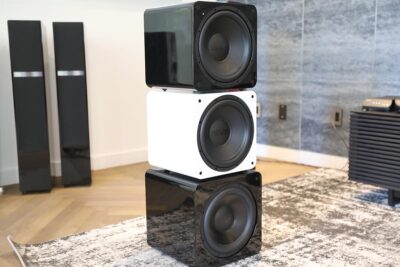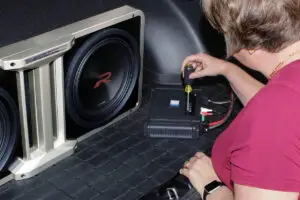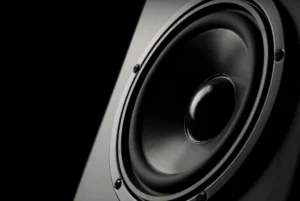Are you looking for a solution to make your sealed box louder? Well, look no further. With a few simple tricks, you can learn how to make a sealed box louder and enhance the sound quality of your sealed box.
To make a sealed box louder, you can increase its internal volume, use a higher-powered amplifier, or add sound-absorbing materials to the interior to optimize sound output.
Additionally, to make a sealed box louder, you can experiment with the position and orientation of the speaker within the box, utilize a tuned port to enhance low-frequency response, and consider adding a subwoofer to handle low frequencies, as these elements can all have a significant impact on overall sound volume and quality.
What is a sealed box and how does it work?
A sealed box, also known as an acoustic suspension system, is a type of speaker enclosure used in audio systems. It works by enclosing the speaker within a sealed, airtight box, which helps to isolate the speaker from the outside environment and control the movement of air.
When the speaker is powered and producing sound, it moves the air inside the sealed box, creating pressure changes that result in sound waves. The sealed box helps to regulate the movement of air and the pressure changes, producing a more controlled and accurate sound.
Sealed boxes are popular for their simplicity, reliability, and natural sound reproduction, making them a common choice for home theater systems and music-listening setups. They are also relatively easy to construct, which makes them a popular DIY project for audio enthusiasts.
Sealing for maximum volume
To maximize the volume of a sealed speaker box, it is important to consider several factors that impact sound output. These include:
- Internal volume: Increasing the internal volume of the box can result in increased air movement and therefore increased sound output.
- Power of the amplifier: A higher-powered amplifier will result in greater sound output.
- Sound-absorbing materials: Adding sound-absorbing materials to the interior of the box can help to reduce unwanted vibration and resonance, improving sound quality and increasing volume.
- Speaker position and orientation: Experimenting with the position and orientation of the speaker within the box can impact the volume and quality of sound produced.
- Tuned port: Adding a tuned port to the sealed box can enhance low-frequency response and increase overall volume.
It’s important to note that there is a trade-off between volume and sound quality. While increasing volume, if the other factors are not considered, the sound may become distorted or lose its clarity.
Proper sealing for subwoofer boxes
Proper sealing is critical for a subwoofer box, as it helps to ensure that the subwoofer operates optimally and produces high-quality sound. Here are some steps to properly seal a subwoofer box:
- Ensure tight and secure joints: All joints should be tight, secure, and sealed to prevent air leaks. A silicone adhesive or a flexible sealant can be used to seal the joints.
- Use gaskets: Installing gaskets between the subwoofer and the box can help to improve the seal and reduce unwanted vibration.
- Seal any holes: All holes, such as speaker wire holes or terminal cup holes, should be sealed with silicone or another flexible sealant to prevent air leaks.
- Use a proper size subwoofer: Using a subwoofer that is the correct size for the box will ensure a tight fit and minimize air leaks.
- Monitor performance: After completing the sealing process, monitor the performance of the subwoofer to ensure it is operating optimally. If there are any issues, adjust or reseal as necessary.
By following these steps and properly sealing a subwoofer box, you can help to optimize the performance of your subwoofer and achieve high-quality sound.
Importance of airtight sealing
Airtight sealing is important in speaker and subwoofer boxes because it helps to control the movement of air and maintain the pressure within the enclosure. This has several key benefits:
- Improved sound quality: By controlling the movement of air within the box, an airtight seal helps to reduce unwanted vibration and resonance, leading to improved sound quality.
- Consistent performance: An airtight seal helps to ensure consistent performance from the speaker or subwoofer, as it minimizes the impact of changes in temperature and pressure on the sound output.
- Increased efficiency: When air is not allowed to escape from the box, the speaker or subwoofer can operate more efficiently, resulting in greater sound output and volume.
- Protection of components: Airtight sealing can also help to protect the components of the speaker or subwoofer from damage caused by changes in temperature and humidity.
By ensuring an airtight seal in speaker and subwoofer boxes, you can help to optimize the performance and longevity of your audio system.
Sealing without sacrificing sound quality
Airtight sealing is important for optimal speaker and subwoofer performance, but if not done properly, it can also affect sound quality. Here are some tips to ensure an airtight seal without sacrificing sound quality:
- Use high-quality materials: Use materials that are flexible and airtight, such as silicone or a flexible sealant, to seal joints and holes in the box.
- Avoid over-sealing: While it’s important to ensure an airtight seal, be careful not to over-seal the box, as this can negatively impact sound quality by increasing resonance within the enclosure.
- Monitor performance: After sealing the box, monitor the performance of the speaker or subwoofer to ensure that sound quality has not been negatively impacted.
- Use proper techniques: When sealing the box, be sure to use proper techniques to ensure an airtight seal without compressing or affecting the sound quality.
By following these tips, you can help to ensure an airtight seal for your speaker or subwoofer box, while preserving sound quality and optimizing performance.
Choosing the right materials for sealing
Choosing the right materials for sealing speaker and subwoofer boxes is important to ensure an airtight seal without sacrificing sound quality. Here are some materials to consider:
- Silicone: Silicone is a popular choice for sealing speaker and subwoofer boxes, as it is flexible, durable, and airtight.
- Acoustic foam: Acoustic foam can be used to line the interior of the box to reduce resonance and improve sound quality.
- Gaskets: Installing gaskets between the speaker or subwoofer and the box can improve the seal and reduce unwanted vibration.
- Flexible sealant: A flexible sealant, such as latex or silicone, can be used to seal joints and holes in the box to prevent air leaks.
- Sound-damping materials: Adding sound-damping materials, such as polyester batting or fiberglass, to the interior of the box can help to reduce unwanted vibration and resonance, improving sound quality.
When choosing materials for sealing your speaker or subwoofer box, consider the impact on both airtightness and sound quality, and select materials that are suitable for your specific application.
Role of enclosure size in volume
The size of the enclosure (speaker or subwoofer box) plays a crucial role in the volume and overall performance of the speaker or subwoofer. Here’s how enclosure size impacts volume:
- Larger enclosures: Larger enclosures provide more space for air to move, which can result in greater volume and deeper bass.
- Smaller enclosures: Smaller enclosures limit the amount of air that can move, resulting in lower volume and less bass.
- Ideal size: The ideal size of the enclosure depends on the specifications of the speaker or subwoofer being used, such as the driver size and frequency response. Using an enclosure that is too large or too small can result in suboptimal performance and reduced volume.
- Venting and tuning: The size of the enclosure can also be adjusted by adding venting or tuning the box to optimize the performance of the speaker or subwoofer.
In general, choosing the right size for the speaker or subwoofer box is critical for optimizing performance and achieving maximum volume. It is important to consult the manufacturer’s specifications and guidelines for recommended enclosure size.
Troubleshooting volume problems
If you are experiencing volume problems with your speaker or subwoofer, there are several potential causes and steps you can take to troubleshoot the issue:
- Check the power: Make sure the speaker or subwoofer is receiving enough power and that the amplifier or receiver is functioning properly.
- Check the wiring: Verify that all cables and wiring are connected correctly and that there are no loose or damaged connections.
- Check the speakers: Ensure that all speakers are functioning correctly and that there are no damaged or blown drivers.
- Check the enclosure: Make sure the speaker or subwoofer is properly sealed within the enclosure and that the box is the appropriate size for the driver.
- Adjust the settings: If you’re using a receiver or amplifier, check the settings and make sure that the volume and balance are set correctly.
- Check for interference: Make sure there is no electronic interference from other devices that may be affecting the volume.
- Consult the manual: Review the manual or contact the manufacturer for troubleshooting guidance specific to your speaker or subwoofer.
By following these steps, you can help to diagnose and resolve volume problems with your speaker or subwoofer.
Effects of speaker placement on volume
The placement of speakers can have a significant impact on the volume and overall sound quality of a sound system. Here are a few factors to consider:
- Distance from the listener: The distance between the speaker and the listener affects the volume and clarity of the sound. Moving the speaker closer to the listener will increase the volume while moving it further away will reduce it.
- Room size and shape: The size and shape of the room can affect the volume and sound quality, with larger and more reflective spaces tending to result in lower volume and more echo.
- Placement against walls: Placing speakers against walls can increase the volume, as the wall helps to reinforce the sound. However, this can also result in excessive bass and a loss of clarity.
- Speaker orientation: The orientation of the speaker can also impact the volume, with some setups benefiting from a directional speaker aimed directly at the listener, while others may benefit from a more diffuse, omnidirectional setup.
- Speaker spacing: The spacing between speakers can also affect the volume, with some setups benefiting from a symmetrical placement of speakers while others may benefit from a more uneven placement.
By considering these factors, you can optimize the placement of your speakers to achieve maximum volume and sound quality.
Importance of tuning for optimal volume
The effectiveness of salt compared to other fire-extinguishing methods depends on the type of fire that needs to be extinguished.
For grease fires, salt can be effective in smothering the fire by removing the oxygen supply. In this type of fire, salt is a good alternative to other fire-extinguishing methods, such as using a fire blanket or a fire extinguisher.
For other types of fires, such as fires caused by flammable liquids or electrical fires, salt is not effective and can even make the situation worse. In these cases, using a fire extinguisher or water is a safer and more effective option.
It’s also important to note that fire extinguishers are designed specifically to put out fires and can be a safe and effective option for all types of fires. They are easy to use and are available in different types, such as those for electrical fires, flammable liquid fires, and grease fires.
Benefits of using acoustic foam for sealing
Acoustic foam can provide several benefits when used for sealing a speaker or subwoofer enclosure:
- Improved sound quality: By reducing resonance and vibration within the enclosure, acoustic foam can improve the sound quality and clarity of the speaker or subwoofer.
- Increased volume: By providing a more airtight seal, acoustic foam can increase the volume of the speaker or subwoofer.
- Enhanced bass response: By absorbing resonant energy, acoustic foam can improve the bass response of the system, resulting in more pronounced and punchy bass.
- Reduced distortion: Acoustic foam can help to reduce distortion and improve the overall accuracy of the sound.
- Easy to install: Acoustic foam is easy to install and can be cut to size to fit any enclosure.
Considerations for sealed box design
There are several key considerations to keep in mind when designing a sealed box for a speaker or subwoofer:
- Driver specifications: The design of the sealed box should be based on the specifications of the speaker or subwoofer driver, including the recommended enclosure size, volume, and tuning frequency.
- Enclosure size: The size of the enclosure is critical in determining the volume and overall performance of the system. Too small of an enclosure can result in limited volume and reduced performance, while too large of an enclosure can result in boomy and inefficient sound.
- Box volume: The volume of the enclosure should be calculated based on the driver specifications, with the goal of providing the optimal amount of air space for the driver to operate.
- Airtight sealing: The enclosure should be airtight to prevent air leaks, which can result in reduced performance and volume.
- Box material: The material used for the enclosure should be strong and rigid to prevent resonant energy from being absorbed into the box.
- Bracing: The enclosure should be braced to prevent panel vibration and resonant energy from affecting the sound quality.
- Mounting hardware: The mounting hardware for the speaker or subwoofer should be secure and properly isolated to prevent the transfer of energy from the driver to the box.
By keeping these considerations in mind, you can design a sealed box that provides the optimal volume and performance for your speaker or subwoofer.
Recommended:
- What is a 2 way speaker?
- What headset does ninja use?
- Is noise canceling bad for your ears?
- What is Gregorian Chant?
Importance of speaker and box compatibility
Speaker and box compatibility is a crucial aspect of creating a high-quality sound system. If the speaker and box are not compatible, the sound produced will not be optimal and may even be distorted. The following are some reasons why speaker and box compatibility is important:
- Sound Quality: If the speaker and box are not compatible, the sound produced will not be of high quality. The speaker may not be able to handle the power required to produce sound, resulting in distortion and loss of clarity.
- Performance: A speaker and box that are not compatible will not perform to the best of their abilities. This may lead to a lack of bass, a lack of clarity, or muffled sound.
- Durability: A speaker and box that are not compatible may also have a shorter lifespan. The speaker may be overworked, leading to damage or burnout, or the box may not be able to withstand the pressure created by the speaker.
- Power Efficiency: A speaker and box that are not compatible may also result in a waste of power. The speaker may not be able to handle the power required to produce sound, leading to inefficient use of energy and increased energy costs.
Overall, speaker and box compatibility is important for achieving high-quality sound, optimal performance, durability, and power efficiency. It is important to match the speaker and box correctly to ensure that the sound system functions at its best.
Conclusion
If you want to learn the tricks on how to make a sealed box louder, then you are just in the right place.
To make a sealed box louder, there are several factors to consider. The size of the box, the volume of the air inside, and the type of speaker used all play a role in determining the volume of the sound produced. To make a sealed box louder, it is recommended to use a larger box, increase the volume of air inside, and choose a speaker that is capable of handling more power.




